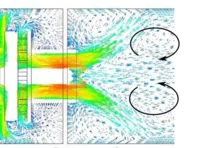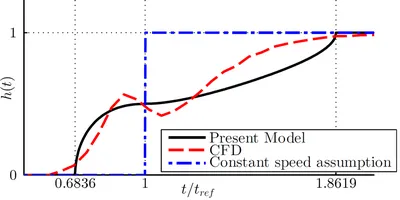Modeling of Swirl Combustion Dynamics
by Alp Albayrak and Wolfgang Polifke
Motivation

The use of swirl in combustion systems is the key point for stabilizing the flame by reheating the cold premixture through the re-circulation zones formed by vortex breakdown phenomenon (see Fig. 1). At the same time, the swirling flow completely changes both flow and flame structures and their interaction. Therefore it is essential to understand the physics behind the swirling flow in combustion in order to predict the instability in the system.
Objectives and Strategy
The purpose of the project is to build low order models by using analytical and numerical tools in order to estimate linear flame dynamics subjected to swirling flows. In order to validate models, high fidelity Large Eddy Simulations (LES) and experimental results are used.
Multiple-Input-Single-Output (MISO) system identification tools are used on CFD and experimental results in order to describe Flame Transfer Function (FTF), which is a well-known approach for analyzing the flame dynamics. It relates the heat release rate fluctuations with the acoustic and swirl perturbations. Moreover, the impact of acoustic perturbations are distinguished from swirl perturbations, which is convenient for modeling purposes.
Results
One parameter that has an important impact on the flame response is the swirler position. By changing the swirler position, the flame dynamics can be altered by the interference between the acoustic and swirl perturbations, which have by nature completely different time scales. The acoustic waves travel with speed of sound. The swirl waves are assumed to be traveling with convective velocities. Since the convective velocities in most combustion systems are at least one order of magnitude smaller than the speed of sound, there is a huge difference between the time scales.
Several experimental and CFD results show that the convective propagation assumption for swirl waves is inadequate. For reliable low order models it is required to build a better model. An analytical model based on inviscid axisymmetric swirling flows is proposed for the propagation mechanism, which describes the propagation mechanism more accurately than the convective propagation assumption.
In Fig. 2 step response results are compared between constant (convective) propagation assumption, new model and CFD data. Azimuthal velocity perturbations are imposed as step function in the entrance of axisymmetric annular tube as input and at some distance downstream the perturbations are measured as output. SI tools are used to compute the step response. The proposed model shows better results than the constant speed assumption, which might be useful for estimation of thermo-acoustic instabilities by Network Models.


Acknowledgement
The presented work is part of the Marie Curie Initial Training Network Thermo-acoustic and aero-acoustic nonlinearities in green combustors with orifice structures (TANGO). We gratefully acknowledge the financial support from the European Commission under call FP7-PEOPLE-ITN-2012.